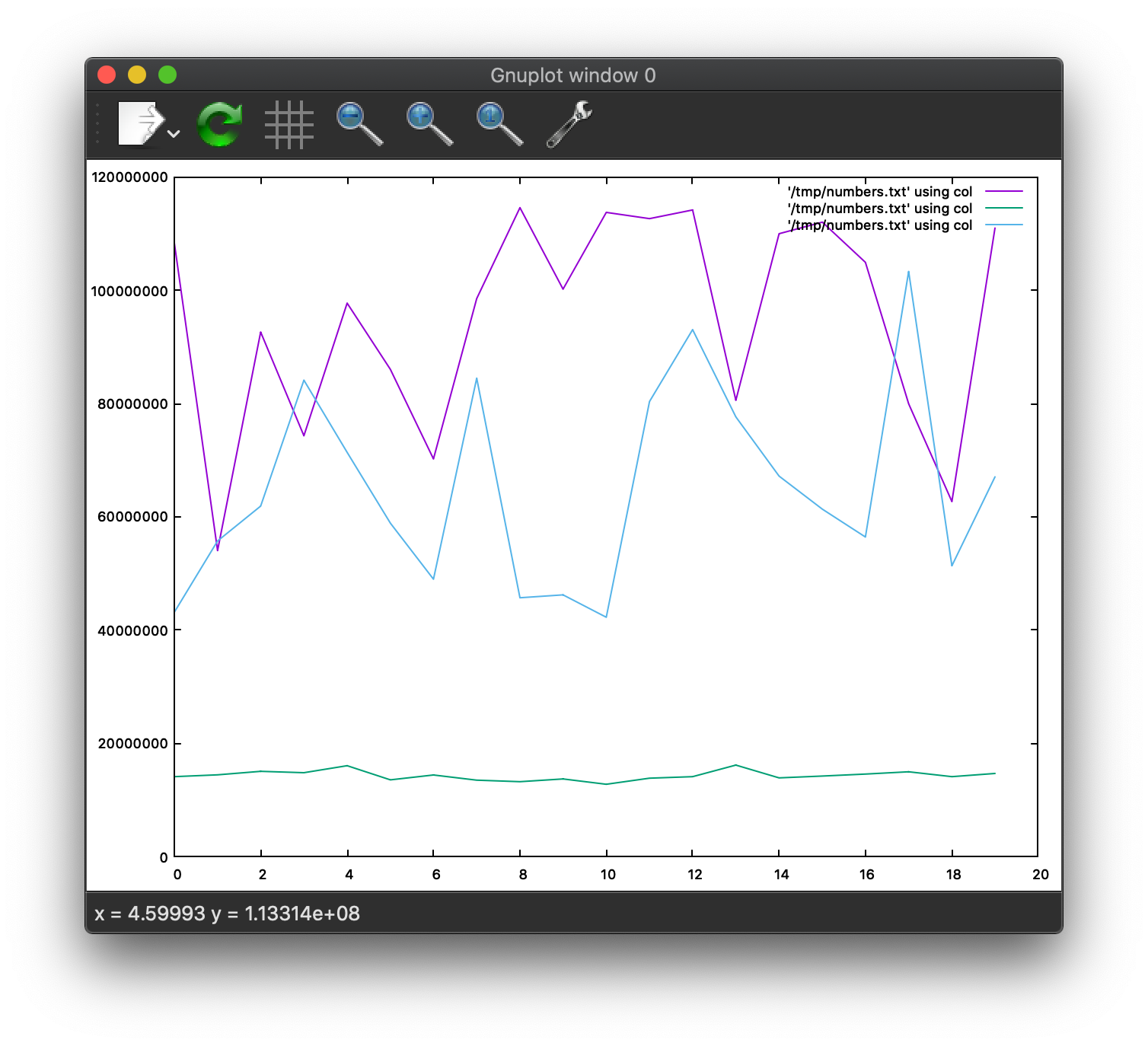Basic GNUPlot from the command line
There are many tools to plot or graph data points. The most common is the spreadsheet. However, there are instances when I would like to quickly analyze a data set then throw away the results when finished.
This is when I turn to GNUPlot for quick ad-hoc graphing.
Using the example data file:
jemurray@mbp-2019:~ $ head -5 /tmp/numbers.txt
108313357.93795292 14172930.125840904 43170655.360387966
54050912.74846953 14506014.564626597 55748443.87279168
92580121.1791793 15119971.132562589 61882800.61125066
74304697.01068823 14867594.969533907 84107289.18697126
97675591.11219549 16117629.751601066 71385054.6928251
Generate a basic graph with GNUPlot:
gnuplot -p -e "set format y '%.0f'; plot for [col=1:3] '/tmp/numbers.txt' using col with lines"
-p -> Keep the window open after the GNUPlot command exits. This is necessary while running in non-interactive mode from the command line, otherwise the image disappears after execution.
-e -> Execute the graphing commands.
set format y '%.0f' -> Change the default Y axis from scientific notation, to standard numbers.
plot for [col=1:3] -> In this example there are 3 columns of numbers in the input file. Create a for loop which graphs each column then plot the data.
'/tmp/numbers.txt -> Input file.
using col with line -> Plot the numbers on a line graph.
The resulting graph will look like this:

This command is not the easiest to remember. By using a Bash function, we can simplify it even more. Add this to the .bashrc:
function gplot() { gnuplot -p -e "set format y '%.0f'; plot for [col=1:20] '$1' using col with lines" ;}
[col=1:20] -> graphs up to 20 columns of numbers in the input file. If a column does not exist, a cosmetic error is displayed.
Example run, which generates the same graph displayed above:
jemurray@mbp-2019:~ $ gplot /tmp/numbers.txt
line 0: warning: Skipping data file with no valid points
line 0: warning: Skipping data file with no valid points
line 0: warning: Skipping data file with no valid points
line 0: warning: Skipping data file with no valid points
line 0: warning: Skipping data file with no valid points
line 0: warning: Skipping data file with no valid points
line 0: warning: Skipping data file with no valid points
line 0: warning: Skipping data file with no valid points
line 0: warning: Skipping data file with no valid points
line 0: warning: Skipping data file with no valid points
line 0: warning: Skipping data file with no valid points
line 0: warning: Skipping data file with no valid points
line 0: warning: Skipping data file with no valid points
line 0: warning: Skipping data file with no valid points
line 0: warning: Skipping data file with no valid points
line 0: warning: Skipping data file with no valid points
line 0: warning: Skipping data file with no valid points
If the graph is not too complex, the terminal can display output in ASCII format. I don’t consider this a good example, but it can be done:
jemurray@mbp-2019:~ $ gnuplot -p -e "set terminal dumb; set format y '%.0f'; plot for [col=1:20] '/tmp/numbers.txt' using col with lines"
120000000 +---------------------------------------------------------------+
| + + + *** ******* + ****+ + |
| ** '/t**/number*.txt'**sing col ******* |
100000000 |-+ * '/tmp/numbers.txt' using co$ #######-|
|* *** * '/tmp/numbe$$.txt' using co$$$$$$$$$ |
|* ** * * $ $$ * $ $ * |
|* * **$$$ *** *$ $ * * $ $ * |
80000000 |-* * $ * * $$ $ $$$ $**$ * +-|
| * * $ * $$$ * $ $ $ $ *$ * |
| * * $ $ $ $ $$$ $ $* $ |
60000000 |-+**$$ $$$ $ $ $ $$$$ $$$ +-|
| $$ $ $ $ $ $ |
|$$ $ $$$$$$ $ |
40000000 |-+ $ +-|
| |
| |
| |
20000000 |-+ ##### #### ##### ##### +-|
|#### ## ######################## ######## #### |
| + + + + + + + + + |
0 +---------------------------------------------------------------+
0 2 4 6 8 10 12 14 16 18 20